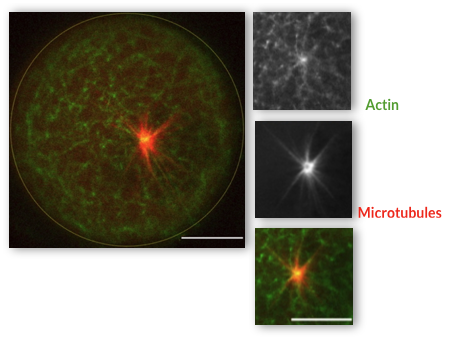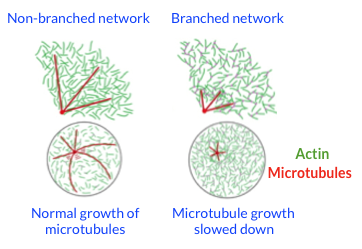The cytoskeleton (i.e. actin and microtubules ) plays a key role in the cell. An increasing number of studies are beginning to demonstrate the existence of coordination between these two networks in a wide range of intracellular processes. However, the mechanisms involved in this crosstalk are largely unknown.
In this work, the Physics of the cytoskeleton
team of the Cell & Plant Physiology Laboratory (Collaboration *) has developed a system to quantify the dynamics of microtubules in the presence of an actin filament meshwork. This approach based on the use of reconstituted systems
in vitro makes it possible to overcome the complexity of the intracellular environment, and to decouple the biochemical interactions from the mechanical interactions. The combined use of reconstituted systems from purified proteins and Xenopus cell extracts allow to identify how an actin meshwork physically constrains the growth of microtubules. Indeed, the actin meshwork blocks the growth of microtubules and triggers their disassembly which reduces their growth rate and their length. In a confined environment, the same actin meshwork can limit the movement of a microtubule aster by acting as an elastic matrix. Finally, if the actin meshwork is dense enough, it can block the assembly of a meiotic spindle.
The retained model is that actin, and more particularly an actin meshwork, can act as a physical barrier that can limit the growth of microtubules. The connectivity within the meshwork increases its rigidity and it can then act as an a physical barrier for microtubule growth. Thus, it is the architecture of actin that imposes mechanical constraints with respect to the growth of microtubules. Microtubules are able to locally modify the architecture of a loosely connected actin meshwork, and to reorganize it in an astral structure.
This work opens up new opportunities to determine how these physical interactions between actin and microtubules may have an impact on the regulation of biological processes such as migration or cell division.
* UMR CNRS 8640 Pasteur (Chemistry Department, ENS), Physics of the cytoskeleton team (Cell & Plant Physiology Laboratory, Grenoble) and Institut Universitaire d’Hématologie (Saint Louis Hospital, Paris).

Example of reconstitution of a microtubule aster in a dense branched actin network (encapsulated Xenopus cell extracts). Scale bar: 10 µm
© Alexandra Colin

Schematic of the effect of actin filament branching meshwork on microtubule growth.
© Manuel Théry